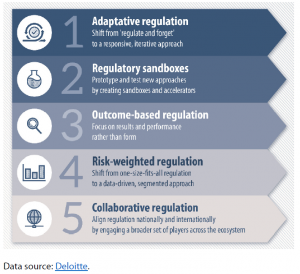Given technological development and changing business models, it is necessary to have adaptive regulation in place. To this end, the ‘smart regulation’ or ‘responsive regulation’ approach helps policy-makers to formulate more flexible, imaginative and innovative forms of policy instruments especially in the field of emerging technologies such as AI and Fintech. While there is no agreed definition of smart regulation, a number of key principles can be identified (see Figure 3). Smart regulation is primarily about responding to the ‘pacing problem’, aiming at cyclical regulation rather than long-lasting rules that set fixed legal standards for decades. Smart regulation is also about responding to the coordination and knowledge problems by being more interactive and including more stakeholders including interest groups, professional bodies, industry associations and quasi-regulators (such as certification bodies). This approach enables legislators to get a more complete and diverse perspective on the issues, as well as potential solutions, while contributing to greater acceptance of regulatory interventions by the relevant stakeholders. Finally, smart regulation requires policy-makers to shift the focus from input to outcome-based regulation, leaving them more room to innovate.
Smart regulation requires a range of new normative instruments, i.e. a smart regulation toolbox. The ordinary EU legislative procedure, whereby it takes years to enact and transpose a text at national level, is not flexible enough. Other mechanisms may be more appropriate, including coordination of national regulators, executive agencies and the use of implementing and delegated acts. Furthermore, smart regulation can be implemented through a broad range of instruments including traditional ‘hard law’ as well as ‘soft-law’ instruments such as notices, guidance, standardisation and certification processes, regulatory impact assessments, periodic evaluation, and sunset clauses, which enable legislators and regulators to constantly re-evaluate the effectiveness and reach of the various instruments. Moreover, rather than going through the lengthy process of legislation, policy-makers could rely upon trial and error through ‘sandboxing’ approaches with rapid feedback and evaluation mechanisms (see box). In this context, a key issue for technology regulation is to balance the use of new flexible instruments – enabling private interests and ideas to drive the rulemaking process – while maintaining legislators’ normative powers to safeguard the general interest.








Be the first to write a comment.